Insecta (2) - Wingless Insects
The Diversity of (Basal) Insects ("Zygentoma")
In simplified form, the higher level classification of the basal insects looks like this:
Insecta
├─Archaeognatha
└─┬─Monura
└─┬─Thysanura
└─Pterygota (i.e. all other insects)
There seems to be general agreement about who belongs here, but no consensus on how to sort them into Archaeognatha, Monura, and Thysanura. Many, otherwise sensible, people continue to use the term "Zygentoma" to refer to the paraphyletic group containing all of these taxa except the Pterygota. We will use the following scheme, which probably keeps everyone together with their closest relatives, but may not put things in the proper buckets.
Insecta
├─Archaeognatha
│ ├─Cercopodata
│ └─Machiloidea
│ ├─Triassomachilis
│ ├─Meinertelidae
│ └─Machilidae
└─┬─Monura (4 assorted extinct genera)
└─┬─Thysanura
│ ├─┬─Lepidotrichidae
│ │ └─Nicoletiidae
│ └─┬─Lepismatidae
│ └─Maindroniidae
└─Pterygota
The particular arrangement of thysanuran families adopted here is stitched together from a few comments about the views of Jules Barlet in Bitsch 2003). Since this is hearsay authority, our arrangement should be taken with even less seriousness than is usual.
We will deal with these basal insects in the same three unequal blocks: the Archaeognatha, the Monura, and the Thysanura. The Pterygota, constituting all the other insects, will be discussed elsewhere. The three groups of immediate interest are sometimes collectively called the "Apterygota," the wingless insects. However, that term is more usually used in the older literature to refer to the paraphyletic group containing springtails and other Parainsecta, in addition to Archaeognatha, Monura, and Thysanura.
|
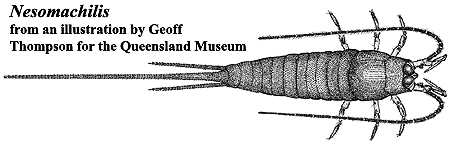 The archaeognaths are the most basal of the true insects and diverged from the Columbella before the close of the Emsian Age of the Early Devonian. Zherikin (2002). Recent Archaeognathae are known as bristletails and are, as the image indicates, quite similar to the Thysanura, or silverfish, with which they are often grouped. They differ from the Thysanura in their form of locomotion, which relies more on jumping (up to 10 cm). This is acheived by flexing the abdominal segments and releasing them like a spring. The archaeognaths are the most basal of the true insects and diverged from the Columbella before the close of the Emsian Age of the Early Devonian. Zherikin (2002). Recent Archaeognathae are known as bristletails and are, as the image indicates, quite similar to the Thysanura, or silverfish, with which they are often grouped. They differ from the Thysanura in their form of locomotion, which relies more on jumping (up to 10 cm). This is acheived by flexing the abdominal segments and releasing them like a spring.
These are all relatively small insects, never longer than 2 cm, most of which is "tail." The head is small, but surrounded by a large notumand appears large. Archaeognaths have rather large, compound eyes, which meet medially and glow if illuminated at night. And wouldn't that be an amusing thing to wake up to? Their name derives from the primitive articulation of the mandibles. The mandibles articulate with the body at only a single condyle joint). All other insects have two condyles. The antennae are long and divided into many short segments. The thorax is stiff and raised at an angle, giving the insect a hump-backed appearance in lateral view. The abdominal body is soft and flexible. It is long, tapers posteriorly, and is covered in tiny scales. Abdominal segments 2-9 bear tiny auxilliary limbs (styles) which are moveable and aid in locomotion. Abdominal segments 1-7 bear eversible vesicles. The body terminates in three long, thin cerci "tails"). The longer middle cercus is actually the 11th abdominal segment. Like all basal insects, Archaeognathae lack wings. |
| |
This is a Permo-Carboniferous fossil group with abdominal appendages and leg- like, segmented cerci. However, cercopodates may have two mandibular condyles, which would be anomalous for true Archaeognatha. Note that, since the "tail" is derived from the 11th abdominal segment, the implication is that the cerci maybe evolved from the limbs of the 11th segment. |
|
 This group may or may not have formal taxonomic status. It includes Archaeognaths of essentially modern form. These extant archaeognaths lay a relatively small number (~12) orange-coloured eggs in crevices or holes bored with their long ovipositors. Fertilization is external. Some species are parthenogenetic (eggs may mature without fertilization). Nymphs are virtually identical to adults, other than in size. They require two or three years for full development. Maturation involves 7-8 molts, and molting continues into adulthood. Bristletails are nocturnal herbivores and detritivores with a very broad dietary range. Significantly, they can survive on algae and lichen -- probably the mainstay of their diet in the Devonian. Archaeognaths inhabit damp environments which may range from coastal cliffs to forest leaf litter in tropical to temperate climates. One species is even known from Alaska. This group may or may not have formal taxonomic status. It includes Archaeognaths of essentially modern form. These extant archaeognaths lay a relatively small number (~12) orange-coloured eggs in crevices or holes bored with their long ovipositors. Fertilization is external. Some species are parthenogenetic (eggs may mature without fertilization). Nymphs are virtually identical to adults, other than in size. They require two or three years for full development. Maturation involves 7-8 molts, and molting continues into adulthood. Bristletails are nocturnal herbivores and detritivores with a very broad dietary range. Significantly, they can survive on algae and lichen -- probably the mainstay of their diet in the Devonian. Archaeognaths inhabit damp environments which may range from coastal cliffs to forest leaf litter in tropical to temperate climates. One species is even known from Alaska.
|
| |
 Shown in ventral view. This is, as the name suggests, a Triassic fossil form. Note that there appear to be only 6-7 abdominal segments, but segments 2-7 do bear styles -- possibly multiple styles. So each abdominal segment probably results from the fusion of two segments. The structure of the region around the cerci, as well as the mandibles, appear simplified when compared with Recent forms. The notum (1st thoracic) is well-developed, but it is impossible to tell if the eyes are large or meet medially. Shown in ventral view. This is, as the name suggests, a Triassic fossil form. Note that there appear to be only 6-7 abdominal segments, but segments 2-7 do bear styles -- possibly multiple styles. So each abdominal segment probably results from the fusion of two segments. The structure of the region around the cerci, as well as the mandibles, appear simplified when compared with Recent forms. The notum (1st thoracic) is well-developed, but it is impossible to tell if the eyes are large or meet medially.
|
|
 Allomachilis, Hypomachiloides, Machilellus, Machilinus, Machilis*, Machiloides, Nesomachilis, Praemachilellus, and others. This is the more common group in most parts of the world and can be distinguished from Machilidae by (a) the absence of scales at the base of the antennae and legs and (b) having very small abdominal styles (pseudo-legs). Allomachilis, Hypomachiloides, Machilellus, Machilinus, Machilis*, Machiloides, Nesomachilis, Praemachilellus, and others. This is the more common group in most parts of the world and can be distinguished from Machilidae by (a) the absence of scales at the base of the antennae and legs and (b) having very small abdominal styles (pseudo-legs).
* Yes. Apparently, Machilis is not a member of the Machilidae. Go figure. |
|
 Dilta, Leptomachilis, Machilanus, Mesomachilis, Pedetontinus Petrobius. The Machilids tend to be slightly smaller than Meinertellids, with a more cylindrical body and more strongly inflected thorax. The thoracic sternals (ventral plates) are triangular. Abdominal segments
1-6 have 1-2 pairs of eversible vessicles. Scutes are present at the base of the antennae and legs. Dilta, Leptomachilis, Machilanus, Mesomachilis, Pedetontinus Petrobius. The Machilids tend to be slightly smaller than Meinertellids, with a more cylindrical body and more strongly inflected thorax. The thoracic sternals (ventral plates) are triangular. Abdominal segments
1-6 have 1-2 pairs of eversible vessicles. Scutes are present at the base of the antennae and legs.
|
The Monura are a group of vague and doubtful affinities. There is a sense in some of the literature that Monura was erected because something ought to occupy this phylospace -- not because the fossil evidence actually compelled that conclusion.
|
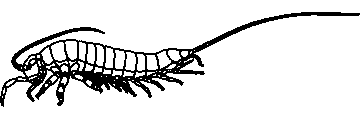 Dasyleptus, Lepidodasypus, Tonganoxichnus. Carboniferous to Permian. This a group of questionable status. Specifically, there is a substantial body of opinion that the fossils assigned to this group are simply immture archaeognaths. One source states that the Monura are all Cercopodata, which seems very plausible. Grimaldi (2001). On the other hand, the argument that "the holotype of taxon X is actually an immature taxon Y" is heard rather often in paleoentomology to explain inconvenient discrepancies. Material from this taxon, if it is a taxon, is extremely scarce, so it is difficult to make judgments. Dasyleptus, Lepidodasypus, Tonganoxichnus. Carboniferous to Permian. This a group of questionable status. Specifically, there is a substantial body of opinion that the fossils assigned to this group are simply immture archaeognaths. One source states that the Monura are all Cercopodata, which seems very plausible. Grimaldi (2001). On the other hand, the argument that "the holotype of taxon X is actually an immature taxon Y" is heard rather often in paleoentomology to explain inconvenient discrepancies. Material from this taxon, if it is a taxon, is extremely scarce, so it is difficult to make judgments.
The characters which have been ascribed to the Monura include: supernumary ocelli (unique), segmented jaw parts (hard to accept on 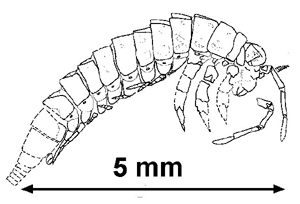 theoretical grounds), mandibles with a single condyle (primitive character shared with Archaeognathae), abdominal styles divided into leg-like segments (a much-sought intermediate state), abdominal cerci absent (or simply missing?), annulated (segmented!?) caudal filament. Kukalová-Peck, who was responsible for many of the extraordinary claims for the Monura, has also argued that the cerci are present as short, leg-like structures with apical claws. theoretical grounds), mandibles with a single condyle (primitive character shared with Archaeognathae), abdominal styles divided into leg-like segments (a much-sought intermediate state), abdominal cerci absent (or simply missing?), annulated (segmented!?) caudal filament. Kukalová-Peck, who was responsible for many of the extraordinary claims for the Monura, has also argued that the cerci are present as short, leg-like structures with apical claws.
Perhaps the truth of the matter is that we simply have too little data to draw a firm conclusion at the moment.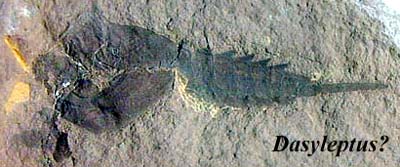 |
With the Thysanura, we return to firmer phylogenetic ground. Recently, a few mischievous junior members of the Molecule Mob have suggested that mayflies evolved from within the Thysanura. In other words, they suppose that flight evolved twice in insects. Nardi et al. (2003). This is unlikely. However, flight is a demanding business. Flying animals tend to diverge far and quickly from their non-flying cousins because of the stringent mechanical demands of flight and the selective pressures faced (and avoided) as a result of the ability to fly. For that matter, mayflies are not morphologically so different from thysanurans that we can reject Nardi's suggestion out of hand. Certainly, this hypothesis is infinitely preferable to the semi-molecular work of Giribet et al. (2001), who require three independent origins of flight (its either that, or flying lobsters -- the choice is yours, folks) and place fruit flies as the sister group of diplurans and barnacles! Nevertheless, more senior Moleculons have intervened, bearing reams of Beyesian statistics showing that no definite conclusions can yet be drawn. Delsuc et al. (2003). Thus the public fisc is once again impoverished to support contending, fruitless speculations -- but, undoubtedly, our discourse is much enriched in compensation.
What all these molecular studies do show is that the Pancrustacea hypothesis is correct. Generations of morphologists have been unable to determine the branching order of Chelicerata, Myriapoda, Crustacea and Insecta. By repeatedly and strongly supporting Pancrustacea, the molecular results shift the weight of evidence decisively in favor of an insect-crustacean clade. We reluctantly concede that molecules have helped immensely to resolve this intractable issue. Flight may have developed more than once, but there are theoretical, as well as morphological, reasons to doubt this. Zherikhin (2002).
|
 Common names: silverfish and firebrats. Estimates of the age of the earliest known Thysanura vary from the Pennsylvanian to the Oligocene. Since this represents a range of almost 300 My, someone's geological clock may have stopped. The earliest estimate is probably correct. Extant silverfish are so named because of the silvery scales that easily separate from the body when the insects are rubbed. It is unclear to us why anyone of even marginal sanity would wish to rub a silverfish -- they are not known to grant wishes or bring good luck. "Firebrats" are thysanurans adapted to high temperatures, and are frequently found as pests in human kitchens, where, like other brats, they attempt to consume anything of even vaguely organic composition -- at no small expense to the family wage-earners, we might add. Common names: silverfish and firebrats. Estimates of the age of the earliest known Thysanura vary from the Pennsylvanian to the Oligocene. Since this represents a range of almost 300 My, someone's geological clock may have stopped. The earliest estimate is probably correct. Extant silverfish are so named because of the silvery scales that easily separate from the body when the insects are rubbed. It is unclear to us why anyone of even marginal sanity would wish to rub a silverfish -- they are not known to grant wishes or bring good luck. "Firebrats" are thysanurans adapted to high temperatures, and are frequently found as pests in human kitchens, where, like other brats, they attempt to consume anything of even vaguely organic composition -- at no small expense to the family wage-earners, we might add.
The body is dorsoventrally flattened. The compound eyes are reduced or absent. If present, the compound eyes are always well-separated. One to three ocelli may be present. Then again, they may not. The mandibles are notable for being covered by a 'beard' of small hairs, as are other parts of the body, including the caudal filament, the tail-like extension at the posterior end. The abdomen has ten segments, and bears two posterior cerci in addition to the aforesaid caudal filament (actually the 11th abdominal segment), just as in the Archaeognathae. However, unlike archaeognaths, the cerci of thysanurans are almost as long as the "tail." This is the source of the taxon name, which combines the Greek word for tasseled (θυσανόεις) with a common suffix for tail (-ουρος). Thus, once again, the Ancient Greeks prove their superior powers of common sense, since only a moron would rub these noxious vermin before giving them a name.
Like other basal insects, silverfish are long-lived, and may survive for up to four years. Compare mice, for example, with a laboratory life-span of two years, the average rock band at 18 months, or the average Ancient Greek at about 30 years. There is surely a lesson here, but it escapes us. Most silverfish occupy the same ecospace presumably occupied by their Carboniferous ancestors -- e.g., under damp plant litter or rocks. Other species of silverfish have crawled out from under the rocks, so to speak, and have evolved adaptations allowing them to live with humans. This, if you think about it, is more than can be said for many humans. Several species are "commensals" in ant or termite colonies, where they may steal the colony's food reserves and devour its young. How, exactly, this behavior qualifies as "commensalism" is unclear. By this measure, a neighborhood drug dealer would qualify as a "commensal." But that is what the textbooks state.
Links: Thysanura with identification key to thysanuran families). |
|
|
 Lepidothrix,
Tricholepidion (extant). This is a relict group, now reduced to one species in northern California (and Oregon?). Ocelli are present. The body lacks scales, and the tarsus has five segments. Interestingly, Tricholepidion is associated with red carpenter ants (genus Camponotus) and is tolerated in their tunnels. Tricholepidion does not digest wood, and appears to be a strict herbivore. We have no information on why it hangs around in this peculiar environment. Tricholepidion may also be found, more conventionally, under leaf and bark litter. The interesting implication is that all surviving Thysanura are descended from a group which was associated with colonial insects -- an insect type which evolved only in the Mesozoic. Lepidothrix,
Tricholepidion (extant). This is a relict group, now reduced to one species in northern California (and Oregon?). Ocelli are present. The body lacks scales, and the tarsus has five segments. Interestingly, Tricholepidion is associated with red carpenter ants (genus Camponotus) and is tolerated in their tunnels. Tricholepidion does not digest wood, and appears to be a strict herbivore. We have no information on why it hangs around in this peculiar environment. Tricholepidion may also be found, more conventionally, under leaf and bark litter. The interesting implication is that all surviving Thysanura are descended from a group which was associated with colonial insects -- an insect type which evolved only in the Mesozoic.
|
|
 Common names: Fishmoths, naked silverfish. Genera: Atelura, Battigrassiella, Coletinia, Cubacubana, Gastrotheus, Lepidospora, Metrinura, Nicoletia, Texoreddellia, Trinemura. Range: The nicoletiids are cosmopoltan, but usually cave or termite-associated forms. Common names: Fishmoths, naked silverfish. Genera: Atelura, Battigrassiella, Coletinia, Cubacubana, Gastrotheus, Lepidospora, Metrinura, Nicoletia, Texoreddellia, Trinemura. Range: The nicoletiids are cosmopoltan, but usually cave or termite-associated forms.
The nicoletiids are small-bodied (7-18 mm). They are blind and often without pigments in the exoskeleton. Galán 2001). The maxillary palps have five segments. The abdomen almost always lacks eversible vesicles. The tarsus has fewer than 5 segments. Galán recognizes two families. The Atelurinae associate with colonial insects. They have scales, and are short, with ovoid bodies. The Nicoletiinae are elongate, predominantly lack scales, and live in forest litter, under rocks, underground, or in caves. |
|
Maindronia. This taxon consists of one genus and three species found in arid regions of Chile, India and Ceylon, where it lives under rocks. This genus lacks ocelli and scales and is closely related to the Lepismatidae, and is often subsumed into that family. |
|
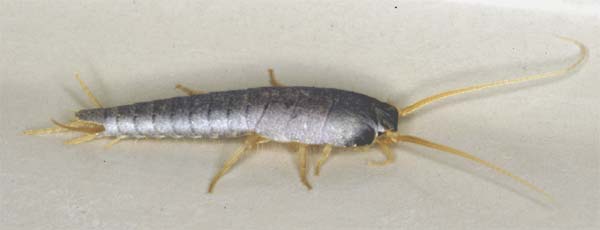 Acrotelsa, Ctenolepisma, Lepisma, Thermobia. These are the typical silverfish and firebrats found in households world-wide. The common household silverfish is Lepisma. Compound eyes are present, but small
& well-separated. The maxillary palps have 5 segments. The body is flattened and rather carrot-shaped. The abdomen usually lacks eversible vessicles. If present, there are only a songle pair per segment. All lepismatids prefer warmer temperatures, and firebrats are particularly thermophilic. Some species are associated with ant colonies. Acrotelsa, Ctenolepisma, Lepisma, Thermobia. These are the typical silverfish and firebrats found in households world-wide. The common household silverfish is Lepisma. Compound eyes are present, but small
& well-separated. The maxillary palps have 5 segments. The body is flattened and rather carrot-shaped. The abdomen usually lacks eversible vessicles. If present, there are only a songle pair per segment. All lepismatids prefer warmer temperatures, and firebrats are particularly thermophilic. Some species are associated with ant colonies.
Image: Lepisma, from Forestry Images. Photograph by Joseph Berger. It appears that the caudal filament and cerci have been truncated in this specimen. There's another excellent image at Lepismatidae with full-length appendages. |
ATW041019. Text public domain. No rights reserved.

 This group may or may not have formal taxonomic status. It includes Archaeognaths of essentially modern form. These extant archaeognaths lay a relatively small number (~12) orange-coloured eggs in crevices or holes bored with their long ovipositors. Fertilization is external. Some species are parthenogenetic (eggs may mature without fertilization). Nymphs are virtually identical to adults, other than in size. They require two or three years for full development. Maturation involves 7-8 molts, and molting continues into adulthood. Bristletails are nocturnal herbivores and detritivores with a very broad dietary range. Significantly, they can survive on algae and lichen -- probably the mainstay of their diet in the Devonian. Archaeognaths inhabit damp environments which may range from coastal cliffs to forest leaf litter in tropical to temperate climates. One species is even known from Alaska.
This group may or may not have formal taxonomic status. It includes Archaeognaths of essentially modern form. These extant archaeognaths lay a relatively small number (~12) orange-coloured eggs in crevices or holes bored with their long ovipositors. Fertilization is external. Some species are parthenogenetic (eggs may mature without fertilization). Nymphs are virtually identical to adults, other than in size. They require two or three years for full development. Maturation involves 7-8 molts, and molting continues into adulthood. Bristletails are nocturnal herbivores and detritivores with a very broad dietary range. Significantly, they can survive on algae and lichen -- probably the mainstay of their diet in the Devonian. Archaeognaths inhabit damp environments which may range from coastal cliffs to forest leaf litter in tropical to temperate climates. One species is even known from Alaska. Shown in ventral view. This is, as the name suggests, a
Shown in ventral view. This is, as the name suggests, a 
 Dilta, Leptomachilis, Machilanus, Mesomachilis, Pedetontinus Petrobius. The Machilids tend to be slightly smaller than Meinertellids, with a more cylindrical body and more strongly inflected thorax. The thoracic sternals (ventral plates) are triangular. Abdominal segments
1-6 have 1-2 pairs of eversible vessicles. Scutes are present at the base of the antennae and legs.
Dilta, Leptomachilis, Machilanus, Mesomachilis, Pedetontinus Petrobius. The Machilids tend to be slightly smaller than Meinertellids, with a more cylindrical body and more strongly inflected thorax. The thoracic sternals (ventral plates) are triangular. Abdominal segments
1-6 have 1-2 pairs of eversible vessicles. Scutes are present at the base of the antennae and legs.



 Lepidothrix,
Tricholepidion (extant). This is a relict group, now reduced to one species in northern California (and Oregon?). Ocelli are present. The body lacks scales, and the tarsus has five segments. Interestingly, Tricholepidion is associated with red carpenter ants (genus Camponotus) and is tolerated in their tunnels. Tricholepidion does not digest wood, and appears to be a strict herbivore. We have no information on why it hangs around in this peculiar environment. Tricholepidion may also be found, more conventionally, under leaf and bark litter. The interesting implication is that all surviving Thysanura are descended from a group which was associated with colonial insects -- an insect type which evolved only in the Mesozoic.
Lepidothrix,
Tricholepidion (extant). This is a relict group, now reduced to one species in northern California (and Oregon?). Ocelli are present. The body lacks scales, and the tarsus has five segments. Interestingly, Tricholepidion is associated with red carpenter ants (genus Camponotus) and is tolerated in their tunnels. Tricholepidion does not digest wood, and appears to be a strict herbivore. We have no information on why it hangs around in this peculiar environment. Tricholepidion may also be found, more conventionally, under leaf and bark litter. The interesting implication is that all surviving Thysanura are descended from a group which was associated with colonial insects -- an insect type which evolved only in the Mesozoic.  Common names: Fishmoths, naked silverfish. Genera: Atelura, Battigrassiella, Coletinia, Cubacubana, Gastrotheus, Lepidospora, Metrinura, Nicoletia, Texoreddellia, Trinemura. Range: The nicoletiids are cosmopoltan, but usually cave or termite-associated forms.
Common names: Fishmoths, naked silverfish. Genera: Atelura, Battigrassiella, Coletinia, Cubacubana, Gastrotheus, Lepidospora, Metrinura, Nicoletia, Texoreddellia, Trinemura. Range: The nicoletiids are cosmopoltan, but usually cave or termite-associated forms.